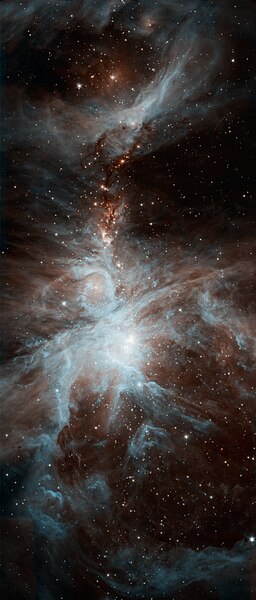Fájl:Spitzer's Orion.jpg
Megjelenés

Az előnézet mérete: 256 × 600 képpont További felbontások: 102 × 240 képpont | 205 × 480 képpont | 328 × 768 képpont | 437 × 1 024 képpont | 2 171 × 5 085 képpont.
Eredeti fájl (2 171 × 5 085 képpont, fájlméret: 1,44 MB, MIME-típus: image/jpeg)
Fájltörténet
Kattints egy időpontra, hogy a fájl akkori állapotát láthasd.
| Dátum/idő | Bélyegkép | Felbontás | Feltöltő | Megjegyzés | |
|---|---|---|---|---|---|
| aktuális | 2010. április 10., 12:31 |  | 2 171 × 5 085 (1,44 MB) | Originalwana | {{Information |Description={{en|1=A colony of hot, young stars is stirring up the cosmic scene in this new picture from NASA's Spitzer Space Telescope. The image shows the Orion nebula, a happening place where stars are born. The young s |
Fájlhasználat
Az alábbi lapok használják ezt a fájlt:
Globális fájlhasználat
A következő wikik használják ezt a fájlt:
- Használata itt: ba.wikipedia.org
- Használata itt: bn.wikipedia.org
- Használata itt: crh.wikipedia.org
- Használata itt: cv.wikipedia.org
- Használata itt: el.wikipedia.org
- Használata itt: en.wikipedia.org
- Használata itt: fa.wikipedia.org
- سحابی شکارچی
- ویکیپدیا:نگارههای پیشنهادی/ستارهشناسی
- ویکیپدیا:نگاره روز/اکتبر ۲۰۱۳
- کاربر:MMjex/نگارههای برگزیده
- ویکیپدیا:گزیدن نگاره برگزیده/مه-۲۰۱۳
- ویکیپدیا:گزیدن نگاره برگزیده/Spitzer's Orion.jpg
- الگو:نر/2013-10-30
- الگو:نر محافظت شده/2013-10-30
- بحث کاربر:MMjex/بایگانی ۱
- ویکیپدیا:نگارههای برگزیده/نگاه به فضا
- Használata itt: fr.wikipedia.org
- Használata itt: is.wikipedia.org
- Használata itt: it.wikipedia.org
- Használata itt: ko.wikipedia.org
- Használata itt: krc.wikipedia.org
- Használata itt: lbe.wikipedia.org
- Használata itt: mk.wikipedia.org
- Használata itt: my.wikipedia.org
- Használata itt: no.wikibooks.org
- Használata itt: os.wikipedia.org
- Használata itt: pl.wikipedia.org
- Használata itt: ro.wikipedia.org
- Használata itt: ru.wikipedia.org
- Használata itt: ru.wikinews.org
- Használata itt: sah.wikipedia.org
- Használata itt: sr.wikipedia.org
- Használata itt: uk.wikipedia.org
- Használata itt: vi.wikipedia.org
- Használata itt: xal.wikipedia.org
- Használata itt: zh.wikipedia.org




